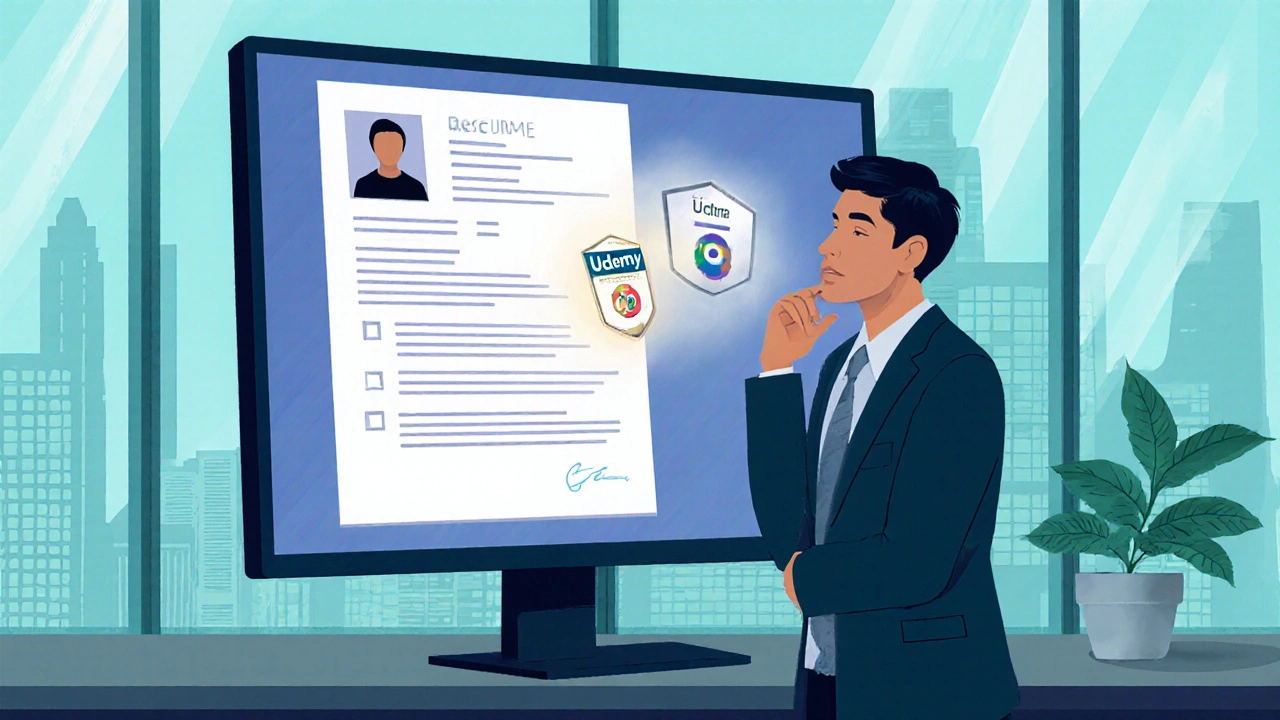Should You List Your Udemy Certificate on Your CV?
 Oct, 9 2025
Oct, 9 2025
Udemy Certificate CV Placement Guide
Recommended Approach
Suggested Presentation Format
Key Tips
About This Tool
This interactive guide helps you determine the best way to include your Udemy certificate on your CV based on your professional situation. It considers factors like experience level, certificate relevance, number of certificates, and project portfolio.
Remember: Quality over quantity. Focus on presenting your most relevant certificates in a way that adds value to your application.
When you finish a Udemy course, the platform instantly offers a downloadable Udemy certificate that confirms you completed the course and lists the skills covered. The big question many job seekers face is whether that piece of paper-or the digital badge-belongs on a professional résumé. Below we break down the decision, show you how to present it cleanly, and explain what recruiters actually think when they see an online‑learning credential.
Why a Udemy Certificate Might Add Value
Employers look for evidence that you can learn fast and apply new tools. A Udemy certificate can serve three practical purposes:
- Skill verification: It tells a hiring manager you have at least baseline knowledge of a specific technology, such as Python, Excel VBA, or Google Ads.
- Demonstrated initiative: Self‑directed learning shows you’re proactive, especially when you’ve taken courses outside your formal education.
- Portfolio bridge: Pairing the certificate with a short project (e.g., a Flask app you built after a Python course) gives concrete proof of ability.
These points matter most for roles that value continuous learning-digital marketing, data analysis, software development, and product management.
When Not to List It
Not every Udemy badge belongs on a CV. Consider skipping it if:
- The course is introductory and the skill is already assumed in the job description.
- You have limited space; a one‑page résumé should prioritize work experience and formal qualifications.
- The certificate isn’t backed by a demonstrable project or outcome.
In those cases, you can still mention the learning in a cover letter or during an interview, where you can elaborate without cluttering the document.
How to Present a Udemy Certificate Effectively
Placement matters. Follow these three formats based on the amount of space you have:
1. Skills‑Based Section
Under a heading like “Technical Skills” or “Professional Development,” add a concise line:
Python (Udemy - Complete Python Bootcamp, 2024)
This tells the reader both the skill and the source without a separate bullet.
2. Certifications Section
If you have multiple online credentials, create a dedicated list:
Certifications - Google Ads Search Certification - Google (2023) - Data Analysis with R - Udemy (2024) - UX Design Fundamentals - Coursera (2023)
Arrange entries in reverse chronological order. Use the official course title to convey credibility.
3. Projects Section with Linked Badge
When you have a portfolio, showcase the certificate as a hyperlink next to the project description:
Project: Sales Forecast Model (Python) - Built a regression model to predict quarterly sales for a retail client. - Udemy Certificate confirming mastery of pandas and scikit‑learn.
Recruiters love a tangible deliverable backed by a badge.
How Recruiters View Udemy Credentials
Data from a 2023 survey of 1,200 hiring managers (HR Research Group) shows:
- 78% consider online‑learning certificates a positive signal of self‑motivation.
- Only 32% view them as equivalent to a university degree or industry‑certified credential.
- When a certificate is paired with a portfolio or work sample, the perceived value rises to 61%.
In plain terms: a Udemy badge alone won’t replace a degree, but it can tip the scales if you back it up with real work.
Comparison: Udemy vs. Other Online Platforms
| Platform | Typical Certificate Detail | Industry Recognition | Cost (per course) |
|---|---|---|---|
| Udemy | Course title, instructor, completion date, hours completed | Growing, especially in tech start‑ups | $10‑$200 (often on sale) |
| Coursera | University‑issued badge, graded assignments, sometimes a final exam | Higher in corporate & academic circles | $39‑$79 per month or specialization bundle |
| LinkedIn Learning | Badge linked to LinkedIn profile, skill assessment | Well‑known among recruiters using LinkedIn Recruiter | $30 per month (all‑access) |
Notice how Coursera often carries a university brand, which can make its badge feel more “official.” Udemy excels in sheer volume of niche topics and price flexibility.

Practical Tips to Avoid Common Pitfalls
- Don’t over‑list. Limit yourself to the three most relevant certificates.
- Verify the badge link. Broken URLs look sloppy; host the certificate on a stable platform or your personal site.
- Match the wording. Use the exact course title so recruiters can verify the content.
- Show results. Pair the badge with a bullet that quantifies impact (e.g., “Reduced data‑entry time by 15% after completing the Excel automation course”).
- Update regularly. Remove older, less‑relevant certificates as you gain professional experience.
Next Steps: Building a Credible Learning Portfolio
Whether you decide to add the Udemy badge directly to your CV or keep it for interview chatter, a solid portfolio amplifies its weight. Here’s a quick roadmap:
- Choose 1‑2 projects that align with the Udemy skill you’ve learned.
- Document the project on a personal website or GitHub repo. Include a brief case‑study (goal, approach, results).
- Link the Udemy certificate next to the project description on both your site and your résumé.
- Update your LinkedIn profile - add the course under “Licenses & certifications” and attach the portfolio link.
Following this loop turns a simple completion slip into a showcase of applied expertise.
Frequently Asked Questions
Is it okay to list a free Udemy course on my résumé?
Yes, as long as the course content is relevant and you can demonstrate how you applied the knowledge. Highlight any real‑world project you built after the course to add credibility.
Should I include the Udemy badge in the “Education” section?
Reserve the “Education” section for formal degrees and certifications. Place Udemy badges under “Professional Development,” “Certifications,” or within a “Projects” description.
Do Applicant Tracking Systems (ATS) read Udemy certificates?
Most ATS parsers look for keywords, not the badge itself. Include the course title and key skills in plain text so the system can index them.
How many Udemy certificates are too many on a CV?
Aim for three to five, focusing on the most job‑relevant ones. Overloading the résumé dilutes impact and can look like a “certification dump.”
Can I replace a missing degree with many Udemy certificates?
Not entirely. A degree still carries weight for many employers, but a strong portfolio backed by relevant Udemy credentials can compensate in skill‑focused roles like web development or digital marketing.